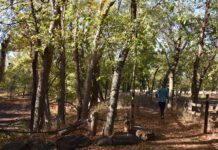Oklahoma’s varied topography lends itself to an array of outdoor activities, but it’s hard to get more primative than simply throwing on a backpack, outfitting yourself with only a tent and a few necessities, and hitting the trail … or at least driving to one of the many campgrounds through the state.
Summertime camping is a challenge because of the heat, but, for those willing to brave it, the satisfaction of communing with nature awaits.
“A lot of people may not realize the natural diversity we have in our state,” says Tom Creider, an Oklahoma State Parks program manager. “We have so many different landscapes – Black Mesa in the Panhandle to tall-grass prairies to the ancient forests in eastern Oklahoma that have trees more than 300 years old.”
Experiencing the outdoors safely requires planning. Adventurers must stay hydrated during these summertime excursions; you should drink water hours before hikes and climbs, not just during and after them. Campfires, stoked with native wood, should be fully extinguished before leaving.
“We request people use only wood purchased from the area where they’re camping,” Creider says. “Wood purchased elsewhere can come from as far away as China and can have invasive insects that can devastate forests.”
He also advises keeping a clean campsite to discourage insects and critters like raccoons and skunks. In some parts of the state where black bears roam, food in a campsite is attractive, but ursine-human encounters are rare.
Insects, however, are not. Summertime campers in Oklahoma find them in abundance. Repellent with at least 25 percent DEET (diethyltoluamide) is preferred, Creider says.
As for camping gear, it’s best to be prepared, but not to go overboard, says Glen Brewington, a longtime camper and employee at Backwoods in Tulsa.
“You need the basics like a tent and a sleeping bag, but you don’t really need a full-blown sleeping bag in the summer,” he says. “You can get away with a liner or 50- or 55-degree rated bag. A lighter bag saves space.”
Water filtration, including purification tablets and a hand-held pump, cleanses water from streams, rivers and lakes to make it suitable for human consumption. Brewington says having such a system is essential in the wildnerness.
Three-season tents, rated for spring, summer and fall, are fine for Oklahoma’s climate, Brewington says.
Clothes also make a difference. Cotton absorbs sweat, dries slowly and should be avoided. Synthetic fabrics that wick moisture away from the skin are the best choices.
Footwear is another critical element.
“Most of Oklahoma’s trails are pretty easy, so you don’t need heavy-duty boots,” Brewington says, “but it’s always a good idea to have a pair of shoes or light boots that are broken in and you know fit. It’s no fun to get out there and have blisters.”
Brewington suggests bringing along lightweight creature comforts; collapsible stools and compact pillows can make roughing it a little more pleasant.
“There are basics that you need and things you can add to bring a little bit of home with you, but the most important thing is not to overdo it,” Brewington says.



























